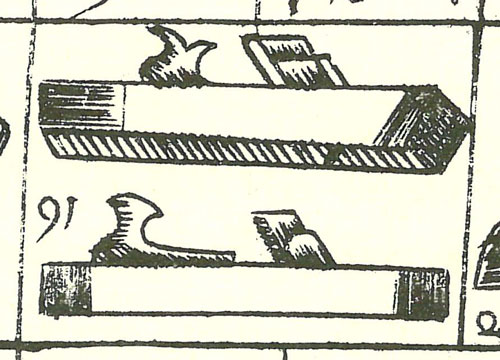
XIX. He beareth in this quarter two sorts of Joyners Plains; that in the chief is termed a Joynter, it is the largest sort of Plains by them used, it is perfectly streight from end to end; its office is to follow the Fore-Plain; and to shoot those things perfectly streight, and to take off those irregularities which remain in the first taking off the Saws roughness in Boards or any other sorts of Timber: It is also used to try all sorts of Tables great or small, by Plaining them Traverse, Angularly, Cornerwise, as well as with the grain, that the Workman may be well assured of the flatness and streightness of the work. Carpenters term this their Long Plain.
V. such a Joynter in Fess between 3 Flowers de lis O. is born by the name of Joyner.
The parts of a Joynter Plain.
The Stock.
The Sole, is the bottom of the Stock which shoots upon the work.
The Handle, by which it is held and thrust forwards. The Tote.
The Bitt, is the Iron as cuts.
The Wedge, it keeps the Bitt fast in its place.
The Mouth of the Stock, is the hole where the Bitt is wedged.
The Breech of the Stock, is the end from the hole or mouth.
The Head of the Stock, from the handle to that end it is at.
The Tote, or Dote, is the handle abovesaid.
A Plain, when all its parts and Members are together.
The second sort of Plain is called the Fore-Plain, and of some the Former, or the course Plain; because it is used to take off the roughness of the Timber before it be worked with the Joynter, or smooth Plain; and for that end the edge of the Iron or Bit, is not ground upon a streight as other Plains are, but rises with a Convex Arch in the middle of it; and is set also more Ranker and further out of the mouth in the Sole of the Stock, than any other Bits or Irons are. The Jack Plain, called so by the Carpenter, is the same that Joyners call the Fore-Plain.
— From Randle Holme’s “The Academy of Armory, or, A Storehouse of Armory and Blazon” Book III, Chapter IX. Why am I reading this?